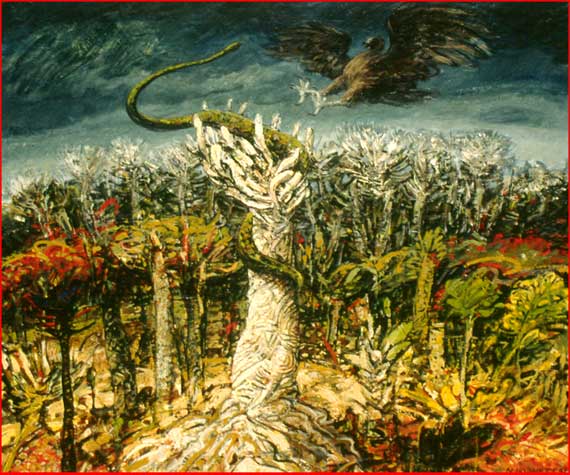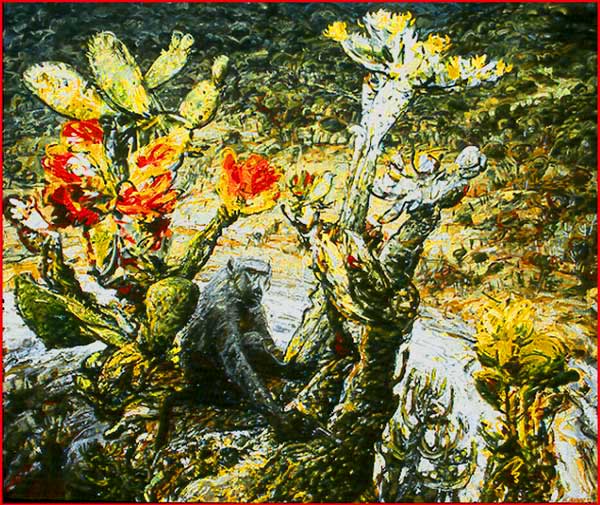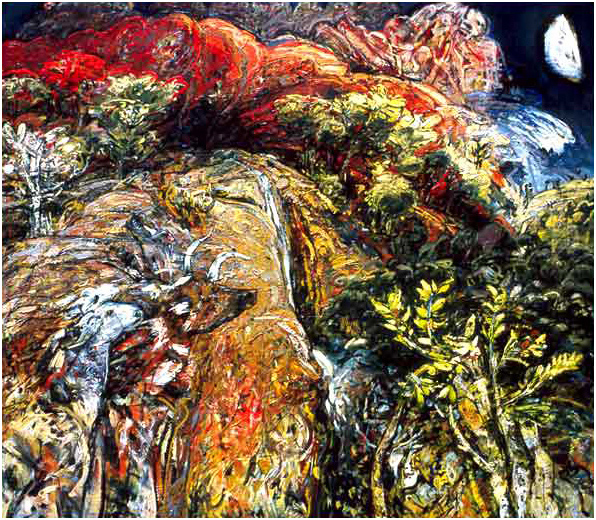 "The
Defence of Yggdrasil" 150cm x 135cm - 1992
"The
Defence of Yggdrasil" 150cm x 135cm - 1992 The following essay was written in August 1992 by Professor M.G.T. Hallier as an introduction to Noel Hodnett's major solo exhibition at the prestigious Standard Bank Centre Gallery in Johannesburg, November 1992.
"NOEL HODNETT" - by Michael Hallier - Professor of Fine Art, Fort Hare Univ., S.A.
It is a pleasurable task for me to write a short introduction to this exhibition of paintings by Noel Hodnett. My task is made easier because as artists we are both concerned with the same environment where earth meets sky. I believe that prior to the 1980s these works would not have hung in a gallery such as this. They would have been regarded as provincial and not part of an authentic vision transcending time. That this exhibition is taking place testifies to the fact that art has undergone tremendous change in recent times.
It is a historical fact that Western culture in the mainstream dried up some 20 years ago: witness the advent of post-modernism. That there is a loss of the feeling of transcendence in our society today is now widely recognized: witness again the return by people from all walks of life to the rediscovery of the holistic character of the world. Today there is a growing global awareness that what we have done to ourselves is directly related to our world view. By moving away from nature we have all but destroyed our planet, as well as our spiritual essence and our feeling for the divine.
Robert Hughes writes: "One of the projects of art is to reconcile us with the world, not by protest, irony, or political metaphors, but by the ecstatic contemplation of the pleasure in nature".
Hodnett was fortunate that he was trained at an art school that did not subscribe to the juggernaut that was modernism, which worshipped the complete autonomy of art. He was fortunate, and indeed still is, to live close to nature. He lives and works in Grahamstown surrounded as it is by bush of the Eastern Cape. His world is dominated by a landscape which to a large extent is still wild and romantic. Also, because much of this area still contains little imprint of both historical and contemporary man, many of his images have little to do with the human presence.
Over the years Hodnett has familiarized himself with the nature and forms of this landscape, so that certain subjects are returned to over and over again. For example, the prickly pear, the rolling contour of hill against sky have been observed into a personal vocabulary.
 "The
Defence of Yggdrasil" 150cm x 135cm - 1992
"The
Defence of Yggdrasil" 150cm x 135cm - 1992
Nature is at one and the same both inviting and hostile, requiring our approach to it to be one of both awe and respect: Hodnett's "tree of life" dominates a paradise world, but the snake holds it in its coils and sways its head menacingly into the world the tree inhabits: his baboon 'guards' a bush-populated river, but the revolver in his hand gives warning that nature can destroy us, and even turn against itself if not approached with reverence.
"Man Hunter" 240cm x 200cm - 1992 
These paintings are not pictures about specific places - they are not descriptive in any sense of the word. Rather they are to be approached as icons that have been constructed with paint as a homage to nature, which the artist believes to be something greater than himself. Landscape here is a bridge between man and the cosmos.
N.H. "Whenever I set out to paint a specific place I inevitably destroy the original image as it always seems to limit and take precedence over the creative act of painting. Painting directly from a drawing imposes similar limitations. I see no point in regurgitating the same image in another medium just for the sake of making a picture".
N.H. "Painting is about constantly changing the norms - especially those of ones own limitations - not working within the safe territory of what has been done before".
Here the forms of the Albany bush are used merely as a vocabulary - the final works have in most cases little or nothing to do with an actual site. Specific places are used only as a triggering-off mechanism to create a tension in the mind which can only be resolved by action. These works are constructed in the studio situation. The canvas is approached vigorously and attacked with lines and colours to get the painting started; the work is allowed to grow and reinterpret itself with the artist's experience and imagination taking precedence over the original source. The painting develops in a way that is not anticipated and the artist amplifies tendencies that have emerged on their own. In most cases, almost completed works are destroyed and live only as a layer of paint under the final image - in some cases a multitude of images are hidden behind the final result: the foreground of a small landscape is now bush, and yet at one stage an albino bush buck lengthened its neck towards the sky. This "event" having occurred has now disappeared with layers of paint, and yet mystically this ritual still persists in the finished work. Many of the paintings exhibit this feeling: it is as though they try to disclose a place in the landscape where an "event" has taken place or been performed. In a few instances we are lucky enough to witness the ritual itself.
N.H. "The realities of painting are for me not about the obvious, but rather about the unpredictability of the accidental and automatic mark that leads one to a dimension that is beyond the mundane. Hopefully all this leads to the essence of what one is trying to get to"
 "Lascaux Moondream" 200cm x 180cm -
1992
"Lascaux Moondream" 200cm x 180cm -
1992
If the manner of painting is largely open-ended, with the artist allowing it to dictate its own terms even to the extent of rotating the canvas many times through 360 degrees during the creation, the final process is a distilling of the image to its most essential forms and shapes. However, this is always accomplished without the loss of the original colour and form which remains intuitive and expressive. These works are not just lyrical expressions of nature, but should rather be seen as celebrations of nature and its spirit calling forth ancient forces that speak of timelessness. These works are filled with lingering spirits of a vast, harsh and yet beautiful area. Most of them contain the feeling of nature as regenerative and restore the capacity to awe and enchantment, qualities so often lacking in our world today. In the final analysis Hodnett is a master of his craft. To substantiate this, one has to look no further than to the fact that all the works are highly formal in structure, which takes precedence over the descriptive, yet this formality always remains hidden.
© M.G.T. Hallier 1992
© Noel Hodnett 1992